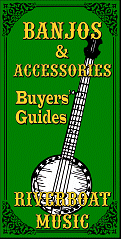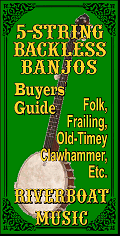Acoustic Instrument
Primers
What Kind of Guitar
Should I Start On?
What Kind of Banjo
Do I Want?
Evaluating and
Buying Used
Guitars
Setting Up
Fretted Instruments Whatever Happened
to the Banjo?
Beginning Five-
String Folk Banjo
6-String Banjos
Banjo Pickups
Axes in my Life
What is a
Bluegrass Banjo?
Dean "Backwoods
Six" Shootout
What is a Zither Banjo?
Music Theory
Primers
Introduction
to Scales
Introduction
to Chords
Circle of Fifths
Other Articles
About Music
How to Give
Guitar Lessons
Musician or
Wannabe? Did God Really
Give Rock &
Roll to You?
Are You a
"Brand Bigot"?
Who Owns Folk Songs?
Historical Links
About the
National Road
The Story Behind
the Story - Real
People, Places,
and Events
About the Play
Play Home
What's New
Overview
About the
Music
About the
History
About the
Logistics
About the
Cast
Synopsis
About the
Set
About the
Author
Contact Us
Home



|

|

Mickey Cochran's Introduction to Banjo Tablature
| Edited by Paul Race for Creek Don't Rise? |
|
Editor's Note: Between 1999 and 2004, Mitchel "Mickey" Cochran posted an extensive collection of free musical instrument lessons on his FolkOfTheWood.com web page. Sadly, we lost Mickey in 2011. After e-mailing surviving family members for permission to repost some of Mickey's most popular materials, we have begun restoring them to host on these pages. (Please see the Introduction page for more information on that effort.) This page is Mickey's explanation of how to read Tablature written for 5-string banjo. - Paul Race |
"How to Read Tablature for 5-String BanjoTablature is one of the oldest forms of written music...it is a visual approach to reading music that gives you an exact position of slide placement on your instrument's slideboard. There are many advantages of tablature that many are not aware of...for instance, if you use different tunings, tablature does not deviate from the standard number positioning; whereas, standard notation has to be re-learned for every tuning. Additionally, standard notation requires a roman numeral positioning to denote where to place your slides. Tablature is much more direct. Ultimately, it's best to become well-versed in both standard notation and tablature. 5-String Banjo TABLATURE: Each
line represents one of the banjo strings. In this 5-String Banjo tab
representation, the top line represents the "D" string...the next below
the "D" would be the "B" string...the next below the "B" would be the
"G" string...and the next below the "G" string would be the low "D"
string...and the next below the low "D" string would be the high "G"
string...So visually, you're looking at the Dobro strings, as
represented by these lines, as upside down. In the below Em Chordal Study example, you'll see the "T", "I" and "M" above the Tablature...this indicates that all notes are played with a downstroke of the thumb and upstrokes with the index and middle fingers. You'll also notice the two dots and double line at the beginning and end of this passage. This means that the piece is to be repeated after reaching the two dots at the end...after reaching the two dots at the end, you'll return to the two dots at the beginning and repeat the passage one more time (or indefinitely if it's an exercise). Chord diagrams are located above the standard notation...in this example, you'll see the Em, D, C and B chords...notice the numbers to the right of the D, C and B chords. This indicates which fret position to play the chord.
In the
case of waltz timing you would have a count of 1 2 3 for each measure.
You'll notice also the line that separates the two measures that run
vertically through the tablature. This line divides each measure so that
you can always tell how many beats are in a measure. If this was a
waltz (3/4) piece, it would look like the following Dobro tablature (as a
5-string banjoist, you'll find very rare occasion to play waltz
timing...even so it's great to know):
The above exercise takes you through a roll pattern in a 4/4 timing. As you're tapping your foot to a count of "4" you'll also notice that you'll want to count 1 & 2 & 3 & 4 & to cover each measure's total beats...the in-between notes will represent the off "and" beat between each tap of your foot. Each downbeat would be a thumbstroke with your right hand or middle finger; each off beat, represented by the "&" symbol, would be played with an upstroke with your right hand index finger...(unless you're left handed and then you would be picking with your left hand). How to read the number system (tablature) Notice that each string of your banjo is represented by a line on the tablature staff. Picture these lines as the strings on your banjo. The very top line is the bottom string of your banjo. The bottom line is the top string of your banjo. The numbers on each line represent where the string is to be played. For instance, a "0" on the top line means to play the D string open. A "2" on the top line means to play the D string at the 2nd fret. In the following exercises, all strings are played open...notice that the only number on the tablature is the numeral "0". These studies are all played in the open position, without fretting, so that the focus will be on the picking hand...to ensure that you're not distracted with having to work both hands at the same time. There are 4 beats to each measure...for each measure count out four beats as if you're keeping the rhythm by clapping your hands or tapping your foot. Note: Keep in mind that you're trying to keep these notes played evenly without faltering. There are no pauses between the notes. Start off slowly and keep the timing even. Thumb = T Copyright ?1999-2004 Mickey Cochran |
Conclusion
Mickey's instructions are as valid today as when he wrote and recorded them years ago. Here's hoping that you find them just as helpful as his original followers did back when he was interacting on a daily basis with them.
Please contact us if you're hitting any brick walls and we'll try to help you get therough them.
Best of luck, all, enjoy your music, and support the arts.
Paul Race
And when you're ready to move on, click Lesson 1a: How to Hold a 5-string Banjo"> here to go to the next online lesson.

All text and any illustrations and/or videos within the white box above are copyright 1999-2004 by Mitchell Cochran. All other materials, illustrations, and content on this web page, including the text reformatting and illustration restoration within the white box are copyrighted ? 2016 by Paul D. Race. All rights reserved.
Creek Dont' Rise(tm) is a participant in the Amazon Services LLC Associates Program, an affiliate advertising
program designed to provide a means for sites to earn advertising fees by advertising and linking to Amazon.com.
For questions, comments, suggestions, trouble reports, etc. about this page or this site, please contact us.
| Visit related pages and affiliated sites: | |||||
| - Music - | |||||

|
 |
 |

|

|

|

|

|

|

|

|

|

|

|

|

|

|

|
| - Trains and Hobbies - | |||||
 |

|

|  |
 |

|
| - Christmas Memories and Collectibles - | |||||
 |

|
 |

|
 |

|
| - Family Activities and Crafts - | |||||
 |

|

|

|

|

|




